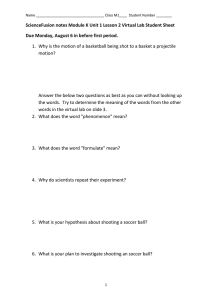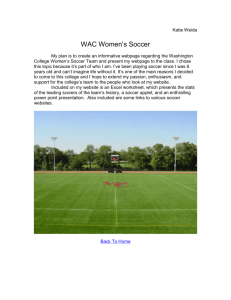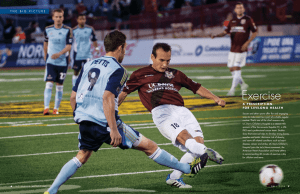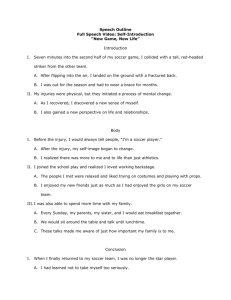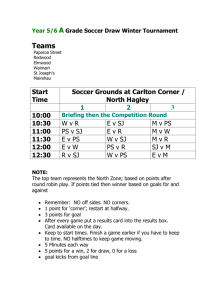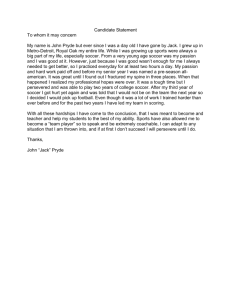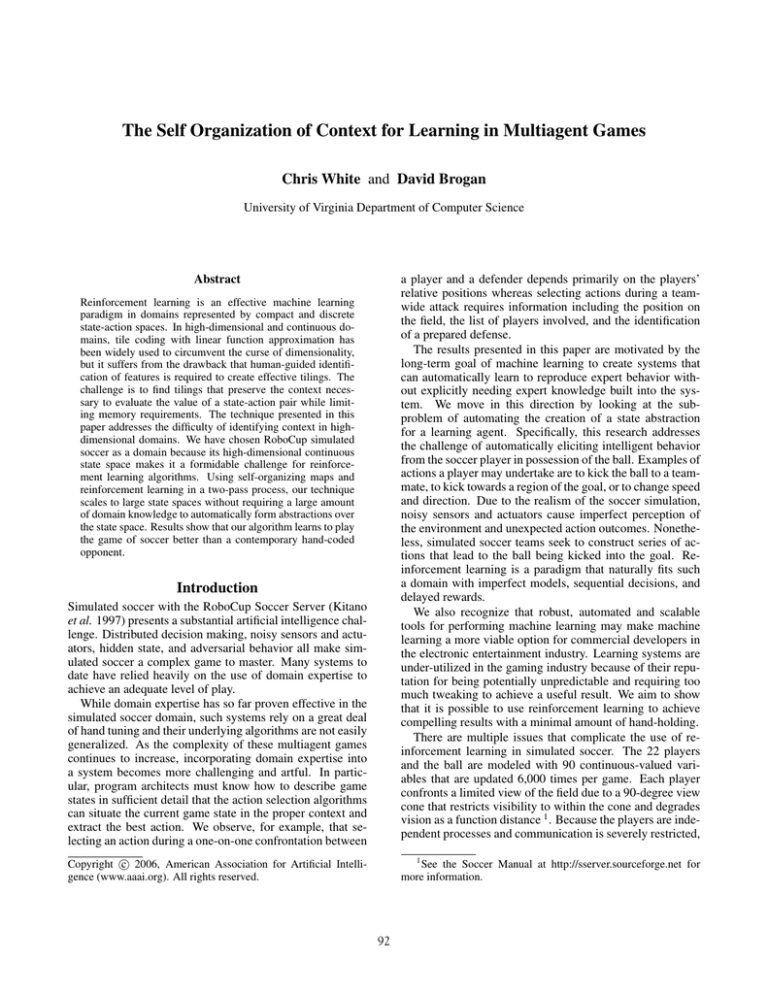
The Self Organization of Context for Learning in Multiagent Games
Chris White and David Brogan
University of Virginia Department of Computer Science
Abstract
a player and a defender depends primarily on the players’
relative positions whereas selecting actions during a teamwide attack requires information including the position on
the field, the list of players involved, and the identification
of a prepared defense.
The results presented in this paper are motivated by the
long-term goal of machine learning to create systems that
can automatically learn to reproduce expert behavior without explicitly needing expert knowledge built into the system. We move in this direction by looking at the subproblem of automating the creation of a state abstraction
for a learning agent. Specifically, this research addresses
the challenge of automatically eliciting intelligent behavior
from the soccer player in possession of the ball. Examples of
actions a player may undertake are to kick the ball to a teammate, to kick towards a region of the goal, or to change speed
and direction. Due to the realism of the soccer simulation,
noisy sensors and actuators cause imperfect perception of
the environment and unexpected action outcomes. Nonetheless, simulated soccer teams seek to construct series of actions that lead to the ball being kicked into the goal. Reinforcement learning is a paradigm that naturally fits such
a domain with imperfect models, sequential decisions, and
delayed rewards.
We also recognize that robust, automated and scalable
tools for performing machine learning may make machine
learning a more viable option for commercial developers in
the electronic entertainment industry. Learning systems are
under-utilized in the gaming industry because of their reputation for being potentially unpredictable and requiring too
much tweaking to achieve a useful result. We aim to show
that it is possible to use reinforcement learning to achieve
compelling results with a minimal amount of hand-holding.
There are multiple issues that complicate the use of reinforcement learning in simulated soccer. The 22 players
and the ball are modeled with 90 continuous-valued variables that are updated 6,000 times per game. Each player
confronts a limited view of the field due to a 90-degree view
cone that restricts visibility to within the cone and degrades
vision as a function distance 1 . Because the players are independent processes and communication is severely restricted,
Reinforcement learning is an effective machine learning
paradigm in domains represented by compact and discrete
state-action spaces. In high-dimensional and continuous domains, tile coding with linear function approximation has
been widely used to circumvent the curse of dimensionality,
but it suffers from the drawback that human-guided identification of features is required to create effective tilings. The
challenge is to find tilings that preserve the context necessary to evaluate the value of a state-action pair while limiting memory requirements. The technique presented in this
paper addresses the difficulty of identifying context in highdimensional domains. We have chosen RoboCup simulated
soccer as a domain because its high-dimensional continuous
state space makes it a formidable challenge for reinforcement learning algorithms. Using self-organizing maps and
reinforcement learning in a two-pass process, our technique
scales to large state spaces without requiring a large amount
of domain knowledge to automatically form abstractions over
the state space. Results show that our algorithm learns to play
the game of soccer better than a contemporary hand-coded
opponent.
Introduction
Simulated soccer with the RoboCup Soccer Server (Kitano
et al. 1997) presents a substantial artificial intelligence challenge. Distributed decision making, noisy sensors and actuators, hidden state, and adversarial behavior all make simulated soccer a complex game to master. Many systems to
date have relied heavily on the use of domain expertise to
achieve an adequate level of play.
While domain expertise has so far proven effective in the
simulated soccer domain, such systems rely on a great deal
of hand tuning and their underlying algorithms are not easily
generalized. As the complexity of these multiagent games
continues to increase, incorporating domain expertise into
a system becomes more challenging and artful. In particular, program architects must know how to describe game
states in sufficient detail that the action selection algorithms
can situate the current game state in the proper context and
extract the best action. We observe, for example, that selecting an action during a one-on-one confrontation between
1
See the Soccer Manual at http://sserver.sourceforge.net for
more information.
c 2006, American Association for Artificial IntelliCopyright gence (www.aaai.org). All rights reserved.
92
decision making is distributed and agents must learn independently.
Of these challenges, we primarily address the difficulty
of learning in large, continuous state spaces. We manage
the large input space of simulated soccer by training a selforganizing map, a Kohonen network, to recognize common
patterns in the state of the soccer game. After this clustering
pass, the state space of the soccer simulation is discrete and
manageable for online reinforcement learning. Our two-pass
learning algorithm is called Kohonen-RL. We demonstrate
the success of Kohonen-RL by competing against teams that
were constructed by hand and by learning algorithms. The
ability to learn effectively using our algorithm speaks to interesting opportunities for clustering systems to capitalize
on the sparse coverage of complex domains and for learning
systems to generalize optimal behaviors across state abstractions.
formally studied in the context of reinforcement learning.
Furthermore, additional experiments are required to demonstrate the effectiveness of state aggregation in real-world applications and to qualify how well such methods scale.
State-Space Reduction
Kohonen networks are widely used in unsupervised pattern
recognition tasks (Pandya & Macy 1996). We look to Kohonen networks to simplify the large soccer state space because their pattern recognition abilities will capitalize on the
game’s sparse sampling. Because the networks are self organizing, we achieve our goal of minimizing the need for
domain expertise.
A Kohonen network consists of two fully connected layers of neurons; an input layer and an output layer, sometimes called the Kohonen layer. The size of the input layer
is determined by the dimensionality of the state extracted
from the problem domain. The size of the output layer is
tunable, whereby a smaller layer promotes greater generalization. Each neuron in the output layer has a weight vector
of dimensionality equal to the size of the input layer. For
a given input, each neuron in the output layer generates an
output according to a user-defined function that measures
the distance between the network’s input and the output neuron’s weight vector. We use a modified L2 distance metric
that normalizes the distance for each dimension by dividing by the standard deviation of that dimension before summing the distances of each dimension. Theoretically, the L1
distance metric creates more contrast between distant states
in high dimensional spaces (Aggarwal, Hinneburg, & Klein
2001), but it is not clear whether or not this actually improves performance of the clustering algorithm. Choosing a
distance metric for a clustering application is an important
decision, but we do not go into the nuances of making such
a decision in this paper.
The neuron from the output layer that generates the lowest distance is defined to be the “winner” and the neuron’s
identifier designates the transformed state of the input. The
weight vector of the winning output neuron is adjusted to
make that output neuron “closer” to the supplied input vector. The adjustment of the j th weight of the winning output
neuron is done according to the following equation:
Related Work
The most relevant research has been conducted in the domain of 3v2 keepaway (Kuhlmann & Stone 2004; Stone &
Sutton 2001; Stone, Sutton, & Singh 2001; Stone, Sutton, &
Kuhlmann To Appear), a sub-domain of simulated soccer.
In this domain, the researchers implement a team of three
keepers and a team of two takers. The goal of the keepers
is to keep the ball away from the takers for as long as possible without kicking the ball outside of a pre-defined region.
To accomplish this, the system uses a one-dimensional tile
coding scheme over thirteen state variables and a Sarsa(λ)
RL algorithm to approximate the value function (Please see
(Sutton & Barto 1998) for background on Sarsa(λ) and tile
coding). Similar systems have been widely used in domains
that have large, continuous-valued input spaces (Sutton &
Barto 1998). Such systems are attractive because the size of
the state-space depends only on the number of tiles, not the
native state space of the application.
Despite the success of reinforcement learning of player
behaviors in 3v2 keepaway, we see reason to continue looking for a method that generates a tractable state-space for the
larger state space of simulated soccer. In order to apply the
tile coding used in 3v2 keepaway, decisions about how to
create the tilings over the soccer state space must be made
by designers. While principled methods to lessen this burden on the designers do exist, it is still a long-term goal of
machine learning to find ways of automatically generating
compact abstractions of large, continuous state spaces.
Parti-game is a reinforcement learning algorithm that uses
game theory and computational geometry techniques to create a state space with varying levels of resolution (Moore
1994). Parti-game only needs to allocate high resolution to
areas of the state space where high resolution is needed, but
it is limited to problems where the dynamics are deterministic.
State aggregation techniques show the most promise for
reducing a problem’s state space in an automated manner.
The underlying theory and convergence proofs for the use
of state aggregation techniques in reinforcement learning
are presented in (Singh, Jaakkola, & Jordan 1995), but the
Kohonen networks utilized in this paper have not yet been
Wjnew = Wjold + α(xj − Wjold )
(1)
Where α is a step-size parameter. See (Pandya & Macy
1996) for more information about equation 1.
In our case, we are primarily concerned with which neuron wins because this serves to identify the transformed and
simplified representation of the soccer game’s state. In more
complicated cases, the network can be trained in a second
pass to output a specific value and to group similar output
neurons close together using localized lateral feedback. We
omit a discussion of these features because although they
contribute to the power of the Kohonen network, they do not
affect the quality of the reinforcement learning.
A Kohonen Network is essentially a clustering tool. We
chose to use Kohonen Networks because of ease of implementation and quick running time, but any number of clus-
93
tering algorithms would have worked as well. We refer the
interested reader to the K-means, K-medians and K-centers
algorithms. In general, increased running time efficiency
sacrifices the quality of the clustering, but we omit a detailed discussion of algorithmic complexity of clustering as
it exceeds the scope of this paper.
In our system, we specify 5,000 output neurons in the
Kohonen network. Because the simulator models imperfect
perception, it is not possible to use all the dimensions that
describe a timestep of a game of soccer in the state space.
Agents can only see part of the field and the accuracy of their
perception degrades with distance, so we limit ourselves to
the following 18 dimensional subset of the full dimensionality of the game of soccer as modeled by the simulator.
any of the current output neurons before a new output neuron must be created for a new pattern. In this extension of
the system, the resolution of the network is being specified
a priori instead of the size of the network.
Reinforcement Learning
Reinforcement learning for control problems is a framework
for learning sequential decision making to maximize a reward. Each action taken is associated with the state in which
that action was taken. After taking an action, the agent receives a reward which is then associated with the state-action
pair that generated that reward. In some reinforcement learning algorithms, a state transition matrix is also learned.
The chained sequence of actions that make up a game
of soccer fit naturally into the reinforcement learning
paradigm. Like other researchers in the field (Kuhlmann &
Stone 2004; Stone & Sutton 2001; Stone, Sutton, & Singh
2001), we state simulated soccer is a semi-Markov decision
process. By semi-Markov decision process, we mean that
although the soccer simulator operates in discrete time steps
of 100 milliseconds each, we do not consider each simulator time step to be a time step in the reinforcement learning
sense. For the purpose of reinforcement learning, we consider a timestep to bound the time of when one agent from
either team first takes possession of the ball until the time
another agent takes possession.
As described in the previous section, the first pass of our
action-selection algorithm uses data collected from 100 soccer games to create a Kohonen network that represents common patterns in the game of soccer. These patterns are
then fixed and become the state space of the second pass
of Kohnonen-RL, the reinforcement learning stage. In this
second pass, the agents play a series of 1,000 training games
against an opponent in order to learn expected rewards for
state-action pairs.
• The Cartesian coordinates of location of the ball on the
field (2 dimensions)
• The polar coordinates of the closest four opponents to the
ball (8 dimensions)
• The polar coordinates of the closest four teammates to the
ball (8 dimensions)
Our choice of 5,000 neurons was arbitrary, but principled
methods for choosing a good number of neurons exist. A
developer could run hte clustering algorithm many times in
parallel and then plot the maximum cluster radius for each
clustering run and use that data to infer what choice for the
number of neurons gives the best balance between finding a
tight clustering but keeping the number of clusters small.
To create our training set, we implemented an omniscient
coach to watch 100 games between several teams from the
2002 Robocup World Championship tournament. The coach
recorded approximately 70,000 input vectors corresponding
to the spatial relationships described by the 18 dimensions
above. We initialized the weights of our output neurons to
the first 5,000 data points in our training set. We then performed 250 training epochs on our Kohonen network using
all 70,000 samples, decrementing the step size parameter α
from equation 1 after each training epoch.
Kohonen networks can effectively compress a highdimensional input space into a relatively compact state space
for a reinforcement learning application because of their
ability to capitalize on the sparseness of a system. The number of possible spatial configurations between players on
the field grows exponentially with the dimensionality of the
inputs that describe those spatial configurations (the curse
of dimensionality). However, the spatial configurations of
players on the field is not random. Player positioning is
guided by the strategy of each team. Therefore, many spatial configurations have extremely low probabilities of occurring. The Kohonen network has the ability to locate configurations that have high probabilities of occurring and to
generalize unseen configurations into configurations that it
has seen before.
A reinforcement learning system based on a Kohonen network is generalizable to other sparse domains. The only decision a designer needs to make is how many output neurons
the network should have. In principle, this decision can be
replaced by specifying the maximum allowed distance from
The Action Space
In control problems, the learning system must choose an action from a set of actions called the action space. An agent’s
policy is the mapping of states in the state space to actions in
the action space. We use a standard − greedy policy to select an action, where the action a with the highest expected
reward is selected with probability 1 − and a random action is selected with probability . We use = 0.125 in our
implementation.
Our action space consists of low-level skills that include
dribbling, passing, and shooting. The following twelve actions were selected from those described in (de Boer & Kok
2002) because of their reliance on a rich state-space description:
• Take a shot on goal
• Pass to one of four closest teammates
• Make a through pass to the closest teammate to the offensive corner of the field
• Clear the ball in the widest angle between opponents
• Clear the ball down the sideline
94
•
•
•
•
if playeri passes to playerk , it will often be the case that
playeri has never visited the state playerk sees. When this
occurs, playeri cannot accurately update its value function
because it does not have an estimate for the value function of
its teammate. We avoid this problem by giving each agent
access to the Q-tables for each of its teammates. We keep
memory requirements low by using hash tables to store the
sparse Q-tables. To obtain an estimate for V π (st+1 , at+1 ),
the agent need only look up the value of V ∗ (st+1 , at+1 ) in
the Q-table corresponding to whichever teammate has the
ball.
Dribble in the direction of the goal
Dribble straight forward
Dribble through the widest gap between opponents
Outplay an opponent by kicking the ball behind it in a
position where the agent will be more likely to reach the
ball than the opponent
We select these actions in order to give the agent a diverse
set of actions from which to choose in the learning process.
Action Evaluation
It is a straightforward process to assign a reward to an action
that is executed during a game. If the action results in a terminal state, an immediate reward can be given to the agent.
For simulated soccer, we consider the following events to be
terminal states:
•
•
•
•
Results
The algorithm described in the previous sections was trained
through repeated playing against a simple opponent and
tested against two contemporary soccer playing algorithms.
We trained our algorithm by running it through 1,000 games
against a team that uniformly samples the set of twelve available actions to select an action for the player with the ball.
Kohonen-RL, by contrast, selects actions for the player with
the ball according to the standard reinforcement learning greedy policy described previously. The two teams are otherwise identical with all non-ball-possessing players returning to a prespecified location on the field according to their
team role (de Boer & Kok 2002).
During the 1,000 games, we tracked the cumulative
goals scored to show the improvement in performance of
Kohonen-RL’s learning (Figure 1). We also record the time
that the ball is in the opponent’s half of the field. Although
the number of goals scored is the only metric that really matters in the game of soccer, it is useful to have multiple metrics of success for the purpose of analyzing this algorithm.
For example, if a team struggles to learn how to complete
a play by scoring a goal but has no problem learning how
to move the ball forward and keep it forward, that information would still be useful in analyzing the performance of
the algorithm.
Figure 1 shows the cumulative scores for our learning
team versus the uniformly random team. We terminate
the graph at 200 games to highlight the bootstrapping period of the learning team’s performance. After 100 games,
Kohonen-RL is winning most of the games and by the end of
the 1,000-game training session, Kohonen-RL has outscored
the random opponent by a 931 to 195 margin. Figure 2
shows the amount of time Kohonen-RL keeps the ball in
its opponent’s half of the field for each of the games in the
1,000-game training session. Kohonen-RL typically keeps
the ball in its opponent’s side of the field more than threequarters of the 6,000-timestep game.
After completing this training period, we test the fully
trained team against a hand-coded team we developed as
a testbed. The hand-coded team uses a strategy that relies
on the location of the ball on the field and implements a
wing-attack offense that tries to push the ball into the corners and then center the ball for a shot on goal. This handcoded team captures a robust strategy for winning simulated
soccer games. Our learning algorithm is capable of playing
as well as, if not better than, the hand-coded testbed. It averages 1.02 goals per game as opposed to 0.86 goals per game
The ball goes out of bounds
Play stops due to a penalty
A goal is scored for either team
The opposing team comes into possession of the ball
The action receives a reward of 100 if it scores a goal on
the opposing team. For all other terminal states, the action
receives a reward of 0. If the action does not result in a terminal state, the Sarsa algorithm described in the next section
determines the reward.
Updating the Value Function
Reinforcement learning algorithms are effective at learning
in Markov Decision Problems because of their ability to take
into account the expected reward of expected future states as
well as the expected reward of the immediate state. In simulated soccer, the probability of transitioning from one state
to any other state is unknown, so we must use a reinforcement learning algorithm that does not need a state transition
model. Temporal Difference learning is one such class of algorithms. Sarsa is a specific Temporal Difference algorithm
that bases its update on the 5-tuple (st , at , rt , st+1 , at+1 ),
where st and at are the current state-action pair, st+1 and
at+1 are the next state-action pair the agent encounters, and
rt is the reward for being in state st . The approximated value
function V ∗ (st , at ) is updated in the following manner:
V ∗ (st , at )
= V ∗ (st , at )
(2)
+ α[rt + γ ∗ V ∗ (st+1 , at+1 ) − V ∗ (st , at )]
where α is the learning rate and γ is the discount rate. Sarsa
stores the value function in a data structure called a Q-table.
Kohonen-RL uses the Sarsa algorithm to approximate the
optimal value function for each action. However, the distributed nature of simulated soccer requires a slight modification to the algorithm. Because the agent’s positioning on
the field is dictated by its position in the team’s formation,
each agent only traverses part of the field. This leads to a
partitioning of the total 5,000-element state space among the
teammates. In our experiments, each agent generally never
visited more than one fifth of the 5,000 states. Therefore,
95
Figure 3: A comparison of Kohonen-RL versus identical reinforcement learning teams that use random state space abstractions instead of a trained Kohonen Network.
Figure 1: The cumulative goals during the first 200 games
of a 1,000-game training period. The Kohonen-RL performance is in black and the random team’s performance is in
grey.
Kohonen-RL vs. Hand-coded Opponent
Opponent win loss tie goals scored against
HC
38
35 26
102
86
Table 1: Results of Kohonen-RL playing 100 games against
a hand-coded testing team.
that learns an abstraction for the state space in its first pass
and learns to associate rewards with state-action pairs during its second pass. Our Kohonen-RL system automatically
identifies 5,000 representative states from a continuous, 18dimensional space and uses those states to learn a value
function for selecting effective actions in any state of the
soccer simulation. The success of the Kohonen-RL team
in the reported experiments demonstrates that reinforcement
learning partnered with self-organizing maps can scale to
complex domains such as simulated soccer with minimal
injection of domain knowledge on the part of the designers. Despite this success, additional work in this field can
tighten the relationship betewen state-space reduction and
value function learning.
An unavoidable conflict in building such simplified simulations is the tradeoff between the ability of the system to
abstract situations via the Kohonen network and the ability
of the system to accurately approximate the value function
V π (st ). This is a well documented tradeoff (Sutton & Barto
1998; Santamaria, Sutton, & Ram 1996), but in many domains its effect is negligible on system performance. However, we found that in simulated soccer, particularly with
certain actions, this tradeoff has a crippling effect on our
system’s ability to to approximate the value function in an
accurate way. We hypothesize that the value of performing
some actions is intolerant of small changes in the state in
which they are executed, thus conflicting with any benefits
of state abstraction. For example, when shooting at the goal,
a two-meter difference in the position of the goalie can make
the difference between a very high V π and a very low V π .
The Kohonen network’s generalization of the context of the
game prevents reinforcement learning from discovering this
very slight difference. The system can therefore never converge to the true value of V π .
Figure 2: The time the learning team is able to keep the ball
on the opposing team’s side of the field. Units of time are
simulator timesteps. There are 6000 timesteps in a game of
simulated soccer.
by the hand-coded team. Table 1 shows the results of 100
games against this hand-coded team.
We further validated our method by comparing it against
two teams with identical -greedy learning policies but with
random state space abstractions. The first random state
space abstraction is completely random; all parameters for
all 5,000 cluster centers were generated with calls to rand()
and normalized to fit into the appropriate range for each
parameter. The second random state space abstraction is
partially random; each of the 5,000 cluster centers were
randomly selected from the set of training points used to
train the Kohonen network. Figure 3 shows the learned
state space abstraction used by Kohonen-RL performs sizably better than either of the random state spaces.
Conclusions and Discussion
We have chosen simulated soccer as a domain for this research because of its high level of complexity. The contribution of this paper is a two-pass, data-driven technique
96
Sampling theory can provide a robust framework for minimizing the error introduced by generalization. A cluster
point in the Kohonen network is essentially a sample point
for the value function being approximated. Minimizing the
error of the value function then becomes a question of deciding where best to put the cluster points. Other researchers
(Santamaria, Sutton, & Ram 1996) who have done work on
this problem have suggested that the state space can be transformed in order to provide high resolution only where it is
needed. This research has primarily allocated higher resolution to frequently visited states, even though these are
unrelated to the more important goal of allocating the high
resolution to regions of the state space where the value function is the most complex. What is really needed is the ability
to expand the resolution in regions of the state space where
the value function experiences high-frequency oscillations.
In future work, we will extend the Kohonen network’s distance function to incorporate data about the difference between the approximated value function in a particular state
and that state’s neighbors in the network. The network will
then be able to retrain itself to super sample the value function for a better approximation.
To economize the allocation of state space in the reinforcement learning process, our future work will develop
action-dependent state spaces. We have presented results
that use 18 dimensions to distinguish optimal circumstances
for action selection. However, it may be the case that the
value function for a particular action only depends on a subset of these 18 dimensions. For example, shooting at the
goal may only depend on the position of the ball on the
field and the position of the goalie. By automatically extracting the relevant state-action features, the dimensionality of the state space can be reduced and a finer mesh over
the state-space can be used to allow the agent to perceive
the variances in state that cause high-frequency changes in
V π (st , a). There has been some recent work on learning to
autonomously identify and ignore irrelevant state variables
(Jong & Stone 2004) that could be applied to creating action
dependent state-spaces, but the problem is still very much an
open one.
Jong, N. K., and Stone, P. 2004. Towards learning to ignore
irrelevant state variables. In The AAAI-2004 Workshop on
Learning and Planning in Markov Processes – Advances
and Challenges.
Kitano, H.; Tambe, M.; Stone, P.; Veloso, M. M.; Coradeschi, S.; Osawa, E.; Matsubara, H.; Noda, I.; and Asada,
M. 1997. The robocup synthetic agent challenge,97. In International Joint Conference on Artificial Intelligence (IJCAI97), 24,30.
Kuhlmann, G., and Stone, P. 2004. Progress in learning
3 vs. 2 keepaway. In RoboCup-2003: Robot Soccer World
Cup VII.
Moore, A. W. 1994. The parti-game algorithm for variable resolution reinforcement learning in multidimensional
state-spaces. In Cowan, J. D.; Tesauro, G.; and Alspector,
J., eds., Advances in Neural Information Processing Systems, volume 6, 711–718. Morgan Kaufmann Publishers,
Inc.
Pandya, A. S., and Macy, R. B. 1996. Pattern Recognition
with Neural Networks in C++. IEEE Press.
Santamaria, J. C.; Sutton, R. S.; and Ram, A. 1996. Experiments with reinforcement learning in problems with continuous state and action spaces. Technical Report UM-CS1996-088, University of Massachusetts.
Singh, S. P.; Jaakkola, T.; and Jordan, M. I. 1995. Reinforcement learning with soft state aggregation. In Advances
in Neural Information Processing Systems, volume 7.
Stone, P., and Sutton, R. S. 2001. Scaling reinforcement
learning toward robocup soccer. In Proceedings of the 18th
International Conference on Machine Learning.
Stone, P., and Veloso, M. 1999. Team-partitioned, opaquetransition reinforcement learning. In RoboCup-98: Robot
Soccer World Cup II.
Stone, P.; Sutton, R.; and Kuhlmann, G. To Appear. Scaling reinforcement learning toward robocup soccer. Adaptive Behavior.
Stone, P.; Sutton, R.; and Singh, S. 2001. Reinforcement
learning for 3 vs. 2 keepaway. In RoboCup-2000: Robot
Soccer World Cup IV.
Sutton, R. S., and Barto, A. G. 1998. Reinforcement Learning: An Introduction. Cambridge, Massachusetts: MIT
Press.
Acknowledgements
We gratefully acknowledge support from the National Science Foundation (ITR 0426971). We would like to thank
David Luebke for allowing us to his his computing clusters
for our simulations. We would like to thank the reviewers
for their insightful and helpful comments.
References
Aggarwal, C. C.; Hinneburg, A.; and Klein, D. 2001. On
the surprising behavior of distance metrics in high dimensional space. In Proceedings of hte 8th International Conference on Database Theory.
de Boer, R., and Kok, J. R. 2002. The incremental development of a synthetic multi-agent system: The uva trilearn
2001 robotic soccer simulation team. Master’s thesis, University of Amsterdam, The Netherlands.
97



